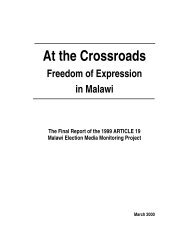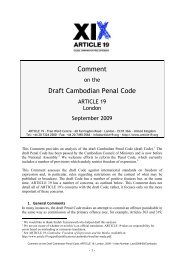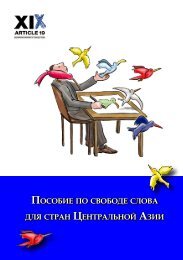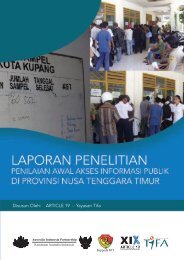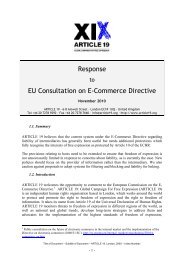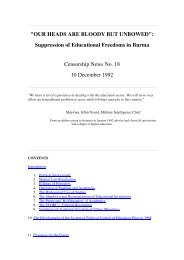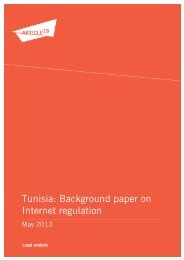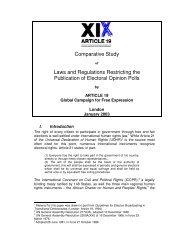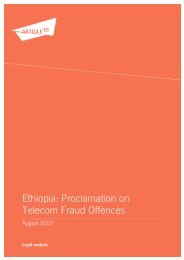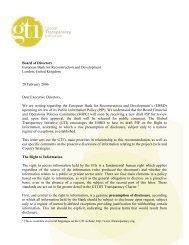FOR INTERNAL USE ONLY - Article 19
FOR INTERNAL USE ONLY - Article 19
FOR INTERNAL USE ONLY - Article 19
- No tags were found...
You also want an ePaper? Increase the reach of your titles
YUMPU automatically turns print PDFs into web optimized ePapers that Google loves.
ARTICLE <strong>19</strong>GLOBAL CAMPAIGN <strong>FOR</strong> FREE EXPRESSIONhard to get rid of them?’ 106 Ukrainian companies that imported acidic tars claimed that they wouldtreat them and neutralise the acid, or re-use them as alternative fuel in a modified version.Environmentalists say that the former did not work and are doubtful that the latter can be safely andsuccessfully carried out. An analysis of the cargo of acidic tars transported by train in April 2003showed that the amount of arsenic was 300-500 times over the limit. 107Nine tonnes of pesticides were also stored in the village of Syanky in Zakarpattya in 2001.When it rained, a stream of water carrying toxic material reached the Syan River, and then travelled toPoland and the Baltic Sea. Mayor Stepan Vasylechko asked the central authorities for assistance, to noavail. Mayor Vasylechko then wrote to the Environmental Minister of Poland, which resulted in aninspection by international experts and international media attention. This finally led to action, and thepesticide was placed in 20 concrete containers. However, six of them cracked shortly after, and fourothers in 2006. With support from international donors, the local NGO WETI organised aninformation campaign, leading to Polish and Ukrainian journalists visiting the affected area. Thecampaign was joined by several stakeholders, including civil society, the media and scientists.Following this, approximately a third of the pesticide was removed and funds were allocated toremove the rest in 2007. 108These cases may fall under the <strong>19</strong>92 Basel Convention on the Control of Trans-boundaryMovements of Hazardous Waste and their Disposal (ratified by Ukraine in <strong>19</strong>99). This would obligeHungary to take back the waste.6%6On 16 July 2007 a train derailed in the Lviv oblast and 15 of its 58 carriages were overturned. Sixcarriages caught fire and there was a spillage of phosphorus, a highly toxic chemical. 109 A toxic cloudspread across approximately 90 sq km, reaching 14 villages with 11,000 residents. 110 By <strong>19</strong> July, 145people had needed hospital treatment for exposure to toxic fumes. 111 There is still no officialassessment of the potential long-term implications of the accident.The media coverage of the incident lasted a week. Conflicting statements were released by theauthorities, creating confusion as to the real significance of the accident on people’s lives and theenvironment. Deputy Prime Minister Oleksandr Kuzmuk compared the accident to Chornobyl on the106 Ibid.107 Ibid.108 ‘Environmental Pollutants Finally Marked for Removal’, 2006,http://www.usaid.gov/locations/europe_eurasia/press/success/2007-03-28.html.109 BBC, ‘Dozens Sick after Ukraine Spill’, 18 July 2007, http://news.bbc.co.uk/1/hi/world/europe/6904924.stm.110 As reported by the Ministry of Health, Fakti Lviv, 18 July 2007.111 ‘145 Hospitalized in Ukraine’, The Associated Press, 20 July 2007.For Internal Use Only. Is Post-Chornobyl Ukraine Ready for Access to Environmental Information?ARTICLE <strong>19</strong>, London, 2007(



